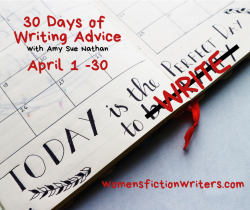Day 2 – 30 Days of Writing Advice – How To Format Dialogue

DAY 2
This month of daily writing advice will include tidbits, tips, and sometimes tricks. This isn’t a replacement for editing or book coaching, it’s meant as a jumping off point for exploration and thought! I hope it helps! ~Amy
Everything You Ever Wanted To Know About Dialogue Formatting But Were Afraid To Ask
Correct dialogue formatting in fiction, folks. It’s a thing.
If you format your dialogue correctly you will immediately improve the reading experience, even in your first draft. And why not do it right, right?
As a book coach and freelance editor I see it all. Here are the corrections for the three most common mistakes I see. There are exceptions, but for the most part these are the rules.
***
Punctuation stays INSIDE quotation marks.
“See what I mean?” “See what I mean”?
***
A pronoun in dialogue tag is NOT capitalized. (of course proper names are capitalized)
“See what I mean?” she asked. “See what I mean?” She asked.
***
Hit return, then type your dialogue. Dialogue, most times, looks like a list. Each speaker gets attention by being on a new line. Everyone likes their own space.
“I know I like my own space,” she said.
“Me too,” he said.
Dialogue, most times, looks like a list. Each speaker gets attention by being on a new line. Everyone likes their own space. “I know I like my own space,” she said. “Me too,” he said.
***
These tips are a great head start. Your manuscript will look better and read better.
Here’s more:
Dialogue tags (he said/she said) stay outside the double quotation marks.
“I created this blog in 2011,” Amy said. “I created this blog in 2011, Amy said.”
Indent the first line of dialogue.
If an action follow dialogue, it is a sentence, not a dialogue tag. End your dialogue with appropriate punctuation.
“I didn’t realize how long this post would take to write.” She rolled her eyes.
“I didn’t realize how long this post would take to write,” she rolled her eyes.
If an action relates directly to HOW the dialogue was spoken, a comma is used and it’s a dialogue tag (more on writing dialogue tags tomorrow).
“I hope this post helps writers,” she mumbled.
If the same character has a lot to say and needs a new paragraph, place opening quotation marks at the beginning of each paragraph. However, closing quotation marks are placed only at the end of the final paragraph. Please take note. This is correct, but it doesn’t mean your characters should ramble on. I might suggest rereading and seeing if you can’t break it up a bit. Reading a Chatty Cathy can be cumbersome.
I may have missed something, but hey, it’s a start.
Some other parts of writing dialogue are stylistic, and I’ve read that some writers have stopped using quotation marks altogether.
“Don’t get me started,” she screamed.
See you tomorrow for more on writing dialogue.
Amy xo
Want me as your writing coach?
Women's Fiction Writers
- Amy Sue Nathan's profile
- 543 followers



